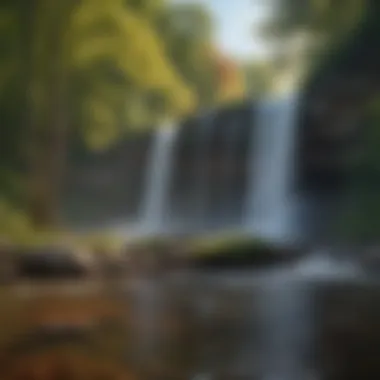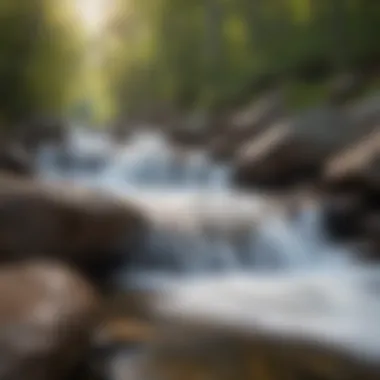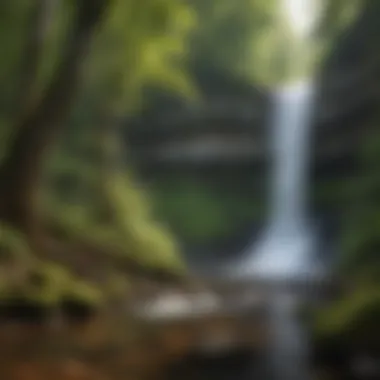Unveiling Upper Michigan's Enchanting Waterfalls


Intro
The waterfalls of Upper Michigan are more than just beautiful natural features; they embody the intricate relationship between ecology, culture, and conservation. With diverse ecosystems surrounding these waterfalls, their significance transcends mere aesthetics, contributing to the region's biodiversity and offering critical benefits to the environment.
This article aims to deeply explore the ecological implications of these waterfalls, their cultural narratives, and the essential role they play in conservation initiatives. From the cascading waters of Tannery Falls to the serene beauty of Bond Falls, each waterfall tells a story about Upper Michigan’s natural heritage and human engagement with the land. Understanding these narratives is crucial for fostering a sense of stewardship among residents and visitors alike.
Forest Ecology and Biodiversity
Importance of Forest Ecosystems
Forests are vital to the health of our planet, providing oxygen, regulating climate, and supporting an incredible array of life. In Upper Michigan, forests serve as crucial habitats for wildlife and play a key role in maintaining the ecological balance. The abundance of water and lush vegetation near waterfalls fosters a rich environment for various species.
The complex interactions within forest ecosystems ensure that species thrive. For instance, certain waterfalls create microclimates that support unique plant species not found in surrounding areas. This biological diversity is essential for ecological resilience and adaptation to environmental changes.
Flora and Fauna in Woodlands
The woodlands surrounding Upper Michigan's waterfalls are home to a rich tapestry of flora and fauna. The dynamics of these habitats can be examined through the lens of specific plant and animal species.
- Trees and Shrubs: Common trees include Eastern hemlock, Red maple, and Sugar maple. Understory plants like ferns and various wildflowers flourish in the moist soil near the waterfalls.
- Wildlife: The area supports mammals like deer, and numerous bird species, including the Wood Thrush and the Black-capped Chickadee. Amphibians also thrive, benefiting from the moisture provided by waterfall environments.
By maintaining these habitats, we help protect not only the species within them but also the broader ecological systems that depend on these water sources. A stressed ecosystem could lead to the decline of both fauna and flora, impacting the entire woodland area.
"Protecting our water sources is protecting our future. The waterfalls of Upper Michigan play a crucial role in sustaining biodiversity in the region."
Sustainable Forestry Practices
Techniques for Responsible Management
Sustainable forestry practices are crucial for preserving the integrity of the forests adjacent to waterfalls. This involves balancing the need for timber production with ecosystem preservation. Practices such as selective logging, reforestation, and the creation of buffer zones around waterways are essential.
These methods not only ensure responsible use of resources but also protect the wildlife that relies on those forests. By maintaining a diverse age structure within the forest, we can enhance habitat quality and resilience against pests and diseases.
Certification Schemes and Standards
Adopting certification schemes like the Forest Stewardship Council and Sustainable Forestry Initiative can guide sustainable practices. These standards offer frameworks for evaluating and improving forest management practices. They ensure that forestry activities do not compromise the ecological functions of the forest associated with the waterfalls.
Community Engagement and Stewardship
Role of Local Communities
Local communities play a critical role in the conservation of Upper Michigan's waterfalls and their surrounding ecosystems. Residents often possess invaluable knowledge about the land and its resources. Engaging them in conservation efforts not only promotes stewardship but also helps in educating others about the ecological significance of these sites.
Community-led initiatives, such as clean-up events and educational programs, can further strengthen the relationship between people and nature. Such involvement fosters a sense of responsibility for the local environment and encourages sustainable practices.
Volunteer Opportunities for Engagement
There are various ways for individuals to get involved and contribute to the conservation of these vital ecosystems. Volunteering for organizations focused on conservation, participating in guided tours that promote awareness, and engaging in habitat restoration projects are just a few examples.


Intro to Upper Michigan Waterfalls
The waterfalls of Upper Michigan evoke a sense of natural beauty and ecological vitality. Waterfalls are significant features within the landscape, serving not only as stunning vistas but also as essential components of the ecosystem. This article aims to unveil the multifaceted characteristics of these waterfalls, emphasizing their geographical attributes, ecological significance, and cultural context. By exploring these aspects, readers can gain a more profound appreciation for the role waterfalls play in both nature and human activity.
Geographical Overview
Upper Michigan is home to a variety of waterfalls that are intricately linked to the region’s geography. The terrain is marked by rugged hills, dense forests, and numerous streams that converge and cascade across the rugged landscapes. Factors such as glacial activity and river systems have shaped the unique waterfall formations found in this area. Notable rivers like the Tahquamenon River and the Ontonagon River have carved deep gorges, providing ideal conditions for the formation of beautiful waterfalls.
The distribution of waterfalls in Upper Michigan can also be attributed to the area's diverse geology. Made up of varied rock layers, including sedimentary and igneous formations, these geological features influence the height, type, and appearance of waterfalls. Rivers meandering through intricate rock configurations create both wide and narrow waterfalls, each presenting its own environmental challenges and scenic allure. An understanding of geographical elements enhances our appreciation of this natural beauty.
Ecological Importance of Waterfalls
Waterfalls serve essential ecological functions in Upper Michigan’s ecosystems. They contribute to the biodiversity of these regions by providing habitats for various aquatic and terrestrial species. The tumbling waters create oxygen-rich environments that support fish populations, such as trout and salmon, which rely on these oxygenated waters for their life cycles.
In addition to aquatic ecosystems, waterfalls influence the surrounding vegetation. The moisture generated by falling water fosters lush plant communities, which in turn support a multitude of animal species. These areas often become biodiversity hotspots, hosting a range of flora and fauna that rely on the unique conditions waterfalls provide.
Furthermore, waterfalls play a crucial role in erosion control and sediment transport. By breaking the force of flowing water, they reduce the velocity at which river sediment is carried downstream. This process helps maintain water quality and prevents detrimental sedimentation downstream, which can affect aquatic ecosystems.
"Waterfalls are more than just beautiful sights; they are vital ecosystems that contribute to the health of the environment and the diversity of life."
Overall, understanding the geographical and ecological aspects of Upper Michigan's waterfalls provides insights into their significance, not only as natural wonders but also as contributors to the overall health of the ecosystem. Their preservation is crucial for maintaining ecological balance, recreational opportunities, and cultural heritage.
Types of Waterfalls in Upper Michigan
Waterfalls in Upper Michigan are not just stunning natural features; they represent a dynamic interplay of geology, hydrology, and ecology. Understanding the different types of waterfalls contributes to a greater appreciation of the region's unique landscape. This section categorizes the waterfalls into three primary types: plunge, cascade, and block. This classification helps in recognizing the distinct characteristics and formation processes of each type, as well as their environmental significance.
Plunge Waterfalls
Plunge waterfalls are characterized by a vertical drop, where the water falls freely without any obstruction from the rocks below. These waterfalls showcase breathtaking beauty, particularly when viewed from a distance. In Upper Michigan, one prominent example is Tahquamenon Falls. The sheer height and powerful flow of such waterfalls create a striking visual impact. The water plunges into deep pools, often leading to significant erosion at the base. The hydraulic action can carve out unique geological formations over time.
The ecological role of plunge waterfalls is profound. They contribute to local biodiversity by creating varied habitats. Fish and other aquatic species often thrive in the circulating waters of plunge pools. Furthermore, these waterfalls can serve as natural barriers, influencing the migration patterns of species.
Cascade Waterfalls
Cascade waterfalls involve water flowing down a series of rocks or ledges, creating a staircase effect. This type of waterfall is often more gentle compared to plunge waterfalls and can be less visually dramatic, yet equally important ecologically. In Upper Michigan, one can find examples of cascade waterfalls in areas such as the Pictured Rocks National Lakeshore.
The flowing water in cascades promotes oxygenation, which is vital for many aquatic organisms. The varied currents create microhabitats that support diverse life forms. Additionally, cascades contribute to the overall health of river systems by filtering sediments and promoting nutrient cycling.
Block Waterfalls
Block waterfalls are defined by a uniformly wide flow of water that cascades over a cliff or rock surface. Unlike plunge waterfalls, the water drops from nearly the same height across its width, offering a different scenic experience. An illustration of a block waterfall can be observed at Bond Falls, where the water spills over a broad rock face.
These waterfalls provide essential ecological functions. They often act as sites for sediment deposition, which can benefit local flora and fauna. The wide spray from block waterfalls can create humid microclimates, fostering unique plant and animal communities. In terms of tourism, these waterfalls attract visitors who appreciate their grandeur and are essential for education and conservation efforts.
Block waterfalls can create unique microclimates, promoting diverse ecosystems that thrive in humid environments.
In summary, the diversity between plunge, cascade, and block waterfalls highlights the complexity and richness of Upper Michigan's aquatic landscape. Each type contributes significantly to the ecological health of the region while providing aesthetic beauty that attracts visitors and researchers alike.


Notable Waterfalls of Upper Michigan
The waterfalls of Upper Michigan are not only breathtaking natural formations but also serve significant roles in local ecosystems and cultural contexts. Understanding the prominence of these waterfalls allows for a deeper appreciation of their beauty and their ongoing contributions to both tourism and conservation efforts.
Tahquamenon Falls
Tahquamenon Falls is perhaps the most famous waterfall in Upper Michigan. It consists of upper and lower falls, presenting a remarkable sight with a total drop of about 50 feet at the upper section. The water's distinct brown color comes from tannins leached from nearby cedar swamps, offering a unique appearance compared to other waterfalls. This location is within Tahquamenon Falls State Park, which spans over 46,000 acres, making it a protected area, promoting both conservation and recreation. Visitors frequently engage in hiking, photography, and simply basking in the natural beauty. The waterfalls also play a role in local history, believed to be a gathering place for Native American tribes.
Munising Falls
Munising Falls can be found in Pictured Rocks National Lakeshore. This waterfall is about 50 feet tall and flows over unique sandstone. A notable aspect is the accessible viewing platform, which allows visitors to appreciate the falls without extensive hiking. The surrounding area houses various trails that lead to picturesque views and diverse flora. Munising Falls illustrates the rich geological history of the region and serves as a crucial habitat for wildlife, attracting birdwatchers and nature enthusiasts alike. Furthermore, Munising contributes to local tourism, with nearby attractions such as boat tours along the Great Lakes.
Bond Falls
Bond Falls, located near Paulding, is famous for its scenic beauty and pronounced cascades. The waterfall drops about 50 feet, and the sight is particularly spectacular during spring melt or after heavy rains. A pathway leads visitors through a well-maintained area where they can observe the waterfall from various vantage points. This makes Bond Falls a popular site for visitors seeking leisure and tranquility. The surrounding forest offers habitat for numerous species, highlighting the ecological relevance of the area. Bond Falls has been recognized not only for its natural aesthetics but as a cultural touchstone, often featured in local art and literature.
Manabezho Falls
Manabezho Falls is situated along the Presque Isle River and stands around 30 feet tall. This waterfall is slightly lesser-known but equally compelling. The area offers a mixture of rugged trails and serene pathways, allowing for a more isolated experience compared to other waterfalls. Visitors can witness the falls from various angles, each providing unique perspectives. The presence of exotic rock formations surrounding the water adds to its allure. Moreover, the importance of Manabezho Falls extends into the realm of historical and cultural narratives, making it a significant element of Upper Michigan's natural heritage.
"The waterfalls of Upper Michigan not only sculpt the landscape but also shape the very identity of the region through their ecological and cultural narratives."
Cultural Significance of Waterfalls
Waterfalls hold more than just aesthetic appeal in Upper Michigan; they are steeped in cultural significance. They serve as landmarks, symbols, and places of gathering for local communities. Their presence influences not only the natural environment but also the cultural and historical narratives of the region. Understanding this multifaceted significance allows us to appreciate how these natural wonders have shaped human experience.
Historical Context
The history surrounding waterfalls in Upper Michigan dates back to the early Indigenous tribes, who regarded these natural features as vital to their way of life. Waterfalls served practical functions, such as providing fish and water sources, and they were often central to tribal stories and traditions. As settlers arrived, these waterfalls continued to inspire awe and wonder, becoming notable landmarks on maps and in travel literature.
Many of the waterfalls are named after local historical figures or events, which reflect the European influence and expansion in the area. For instance, Tahquamenon Falls is named after the river, which means "the river of the yellow water" in the Ojibwe language. Such names help keep cultural memory alive and connect contemporary visitors to their historical roots.
Indigenous Perspectives
Indigenous peoples, including the Ojibwe and the Menominee, maintain a profound connection to the waterfalls of Upper Michigan. They view these sites not merely as physical features of the land but as sacred places imbued with spiritual significance. Traditional stories often share lessons about respect for the environment, echoing a philosophy that sees humans as integral to the ecosystem.
These perspectives are reflected in ceremonies, rituals, and seasonal activities tied to water. For example, waterfalls often serve as locations for gatherings to celebrate the changing seasons or to conduct spiritual rites. Respectful stewardship of these natural resources is thus paramount, highlighting a deep-rooted sense of responsibility toward the environment.
"Waterfalls are sacred places where our ancestors gathered, learned, and honored the spirits of our land. Their significance transcends simple beauty." — Indigenous Cultural Leader
The current conservation efforts aimed at preserving these waterfalls echo the teachings of Indigenous communities. By incorporating traditional ecological knowledge into modern practices, there is an opportunity to foster a sustainable future for both the natural features and the cultures they support. Through this lens, waterfalls become symbols of resilience, bridging the past and present while emphasizing the need for ongoing respect and preservation.
Impact of Human Activity
Understanding the impact of human activity on the waterfalls of Upper Michigan is essential for the preservation of these natural wonders. This section covers various elements, including tourism, conservation efforts, pollution, and environmental concerns. These topics examine how human presence influences the physical landscape, the ecosystems surrounding these waterfalls, and the future of both tourism and conservation agendas.
Tourism and Conservation Efforts


Tourism plays a significant role in the economy of Upper Michigan. It brings visitors to explore the natural beauty of the waterfalls, thus generating revenue for local businesses. This influx of visitors increases awareness about the area's natural resources. However, with increased foot traffic comes a responsibility to protect these delicate environments. Sustainable tourism initiatives aim to balance economic benefits with ecological preservation.
Visitors contribute to conservation when they engage with educational programs offered in parks and natural spaces. Initiatives like guided tours and workshops inform tourists about local flora and fauna. This awareness can foster a sense of stewardship among visitors. As they learn, they may feel more compelled to protect these treasures.
However, there are challenges associated with this impact. Overcrowding can lead to erosion of trails and damage to surrounding vegetation. Proper management is crucial to mitigate these effects. Conservation areas must have clear guidelines on visitor behavior and access. It is vital for authorities to enforce these guidelines to ensure the sustainability of both the tourism sector and natural environments.
Pollution and Environmental Concerns
Pollution remains a pressing issue affecting the waterfalls of Upper Michigan. Runoff from agricultural fields, urban areas, and industrial sites can lead to significant environmental degradation. Contaminated water sources affect not only the waterfalls but also the ecosystems in the surrounding areas.
Additionally, littering from visitors poses another challenge for conservation efforts. Items like plastic bottles and food wrappers can endanger local wildlife and harm the natural aesthetic of the waterfalls. To combat these issues, authorities and communities are working together to develop clean-up programs. Educational campaigns that emphasize the importance of keeping natural spaces clean are also key.
Moreover, local organizations are conducting regular assessments of water quality. Protecting the watersheds is essential to maintain the health of the waterfalls. Volunteer initiatives can inspire community involvement, encouraging people to partake in restoring and preserving their natural environment. Such efforts not only help mitigate pollution but also strengthen community ties.
"Protecting Upper Michigan's waterfalls is not just a responsibility, but an opportunity for present and future generations to enjoy and learn from these natural treasures."
In summary, the impact of human activity, encompassing both tourism and pollution, plays a crucial role in shaping the environmental landscape of Upper Michigan's waterfalls. By promoting sustainable tourism practices and addressing the challenges posed by pollution, stakeholders can work towards a balanced coexistence with these vital ecosystems.
Access and Preservation
Understanding the significance of access and preservation is essential in the context of Upper Michigan's waterfalls. Access to these natural wonders enables a connection between visitors and the environment. With proper access, individuals can experience the majestic beauty of these waterfalls, fostering a sense of appreciation. However, access must be carefully managed. Increased foot traffic can lead to erosion, degradation of habitats, and other environmental concerns. Therefore, balancing visitor access with the need for conservation is key.
Trail Access and Conservation Areas
Trail access to waterfalls provides numerous benefits. Accessible trails allow people to enjoy the unique scenery and understand the ecosystems surrounding the falls. Conservation areas play an important role in protecting these spaces. These regions often include designated trails that minimize impact while promoting education about the environment.
Efforts to maintain these trails are critical. Regular maintenance prolongs their usability and reduces the risk of damage to sensitive areas. Designating certain paths also keeps foot traffic concentrated, helping to protect wildlife habitats and vegetation. Thinking about safety is also necessary. Well-marked trails prevent visitors from wandering off into potentially dangerous or fragile areas.
"Conservation of natural landscapes is vital, as it ensures the continued health and beauty of our environment for future generations."
Best Practices for Visitors
Visitors are encouraged to adopt best practices when exploring Upper Michigan's waterfalls. By adhering to these practices, individuals can enjoy their experiences while supporting conservation efforts.
- Stay on Designated Trails: Sticking to marked paths minimizes environmental disruption.
- Leave No Trace: Carry out what you bring. This simple act reduces litter and promotes a clean environment.
- Observe Wildlife from a Distance: Protecting local fauna ensures their ongoing survival and well-being.
- Respect Signage: Following signs helps maintain safety and the integrity of the natural space.
- Educate Yourself: Understanding the local ecology can deepen appreciation for these landscapes.
By implementing these practices, visitors contribute positively to conservation efforts. This approach strengthens the relationship between humans and the natural world, fostering stewardship and reverence for these stunning waterfalls.
End
In evaluating the waterfalls of Upper Michigan, this article underscores their vital ecological and cultural roles. These natural wonders are not just picturesque; they bring together a complex web of environmental interactions and human experiences that shape their significance. By highlighting their beauty and fragility, we are prompted to consider the implications of our actions on these ecosystems.
Future Perspectives on Waterfall Conservation
The future of waterfall conservation in Upper Michigan hinges on thoughtful stewardship and proactive measures. As more visitors are drawn to these landscapes, it becomes essential to balance recreation with preservation. Expanding educational initiatives can raise awareness about the importance of these sites and the need for conservation.
Promoting sustainable tourism is another crucial aspect. If visitors are educated on best practices, such as not littering and staying on designated trails, the ecological integrity of these locations can be maintained. This leads to healthier ecosystems, which are less vulnerable to both natural and anthropogenic pressures.
Supporting local conservation efforts with appropriate funding and initiatives can enhance the resilience of these waterfalls against environmental threats. Collaborative efforts between governmental agencies, local communities, and environmental organizations can drive effective strategies for managing and protecting these unique natural resources.
"Conservation is a state of harmony between man and land." - Aldo Leopold
By engaging with these various stakeholders and integrating scientific research into management practices, we can work towards a future where the waterfalls of Upper Michigan thrive both as natural attractions and as essential components of the regional ecosystem. The path forward requires not only appreciation but also active participation in their protection.















